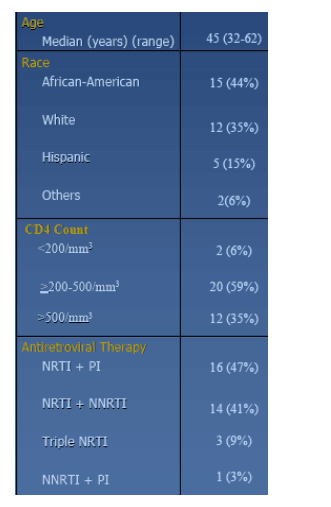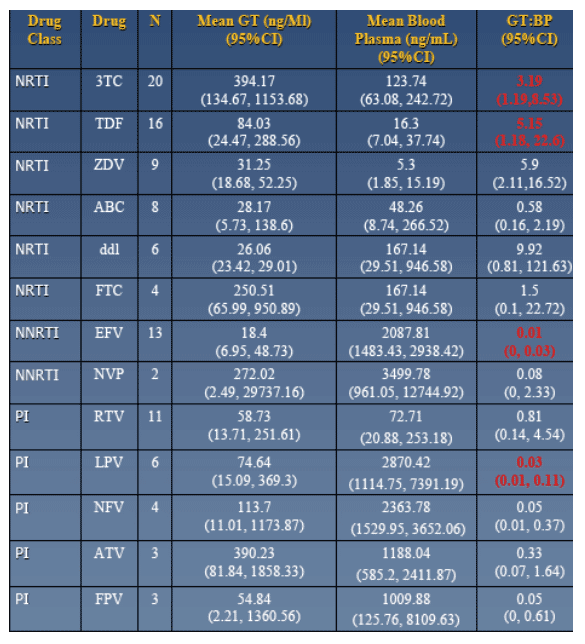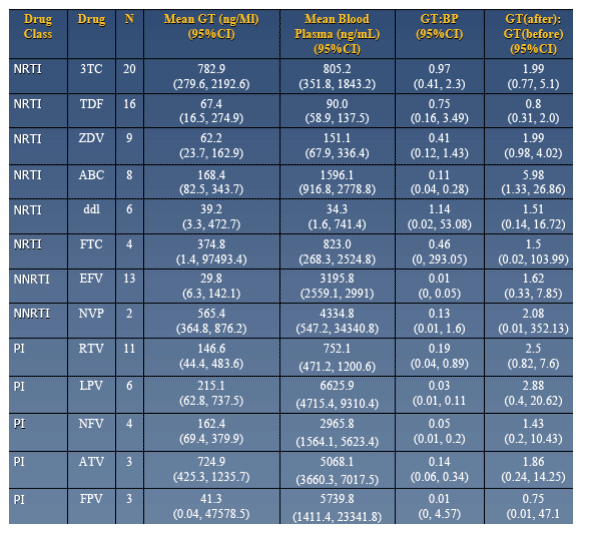 |
 |
 |
| |
ART Drug Concentrations in the Genital Tract of HIV-Infected Women
|
| |
| |
Reported by Jules Levin
CROI, Feb 2007, Los Angeles
S. Cu-Uvin1, A. DeLong1, N. Rezk2, J. Hogan1, H. Burtwell1, S. Chapman1, C. Moreira1, J. Kurpewski1, J. Ingersoll3, A. Caliendo3, A. Kashuba2
1 Brown University, Providence, RI, 2 University of North Carolina, Chapel Hill, NC,3 Emory University, Atlanta, GA
Background
Antiretroviral (ARV) drug concentrations may differ in the genital tract (GT)
and blood plasma (BP). Drugs that poorly penetrate the GT may lead to increases in GT viral load and possible development of resistance. ARV drugs that can achieve good concentrations in the GT may be appropriate for prevention of sexual transmission of HIV. We assessed GT antiretroviral
therapy concentrations among women on chronic highly active antiretroviral therapy (HAART).
Methods
34 women on HAART with plasma viral load < 80 copies/mL for at least 6 months were enrolled in an ongoing study. Paired direct GT aspirate and blood samples were collected in the morning prior to ART intake and 3-4 hours after.
Drug concentrations in BP were measured using validated HPLC/UV methods, and concentrations in GT aspirates were quantified using HPLC-MS/MS method. Assay sensitivity was 1ng/mL for ABC; 5ng/mL for 3TC, ZDV, FTC, LPV, ATV and EFV; and 10ng/mL for TDF, ddI, d4T and RTV. Detectable concentrations below the limit of quantification were set to 0.5 times the lower limit of quantification. Analytical work was performed by the University of North Carolina Center for AIDS Research Clinical Pharmacology and Analytical Chemistry Core.
Drug concentrations were log-transformed prior to analysis; ratios and 95% CIs were estimated by back-transforming the difference in means and CIs of the paired BP and GT drug concentrations at each time period and of the GT concentrations following and prior to ARV drug intake.
Tests and confidence intervals associated with ARV drugs with fewer than 5 samples may not be reliable but were included as preliminary information.
PVL and genital tract (GT) viral loads were quantitated by NASBA (Nuclisens) with a lower limit of detection of 80 copies/mL for plasma and 3,300 copies/mL for genital secretions. GT secretions from the endocervix, ectocervix, and vagina were collected by Sno-strips.
RESULTS
Table 1: Characteristics of the study participants. Average age 45 yrs; 44% were African-American, 35% white, 15% Hispanic. 59% had 200-500 CD4s, 35% >500 CD4s, 6% <200 CD4s. 47% were taking PI+NRTI regimen, 41% NNRTI+NRTI, 9% triplr NRTI, 3% NNRTI+PI.4)

The ARV drugs that have higher extracellular concentrations in the GT compared to that in the BP at the end of the dosing interval (8-12 hours) are 3TC and TDF (note from Jules Levin: in table 2 it appears to me that Reyataz & NVP had the second & third highest levels in the GT at the end of dosing). The ARV drugs that have significantly higher concentration in the BP than in the GT at the end of the dosing interval are EFV and LPV.
(in table 2 below):
Mean GT (ng/MI):
3TC: 394
TDF: 84
AZT: 31
ABC: 28
FTC: 250
ddI: 26
EFV: 18
NVP: 272
LPV: 74
NFV: 113
ATV: 390
FPV: 54
Table 2. Steady state concentrations and 95% confidence intervals of antiretroviral drugs at the end of dosing interval (8 to 12 hours) in the genital tract and blood plasma.
GT: genital tract
BP: blood plasma
GT:BP : genital tract to blood plasma antiretroviral drug concentration ratio at end of dosing interval

The antiretroviral drugs that showed significant increase in concentrations in the GT after dosing are ABC and RTV.
There was only one woman with detectable GT and plasma viral load. Plasma viral load was 1,400 copies/mL ; genital tract viral load was 3,360 copies/mL, 6,000 copies/mL , and <3,000 copies/mL in the endocervix, ectocervix, and vagina, respectively. She was on EFV, 3TC, and ddI. She had detectable levels of EFV and 3TC in the blood and genital tract at the end of the dosing interval.
Table 3. Steady state concentrations and 95% confidence intervals of antiretroviral drugs at 3-4 hours after dosing in the genital tract and blood plasma.
GT: genital tract; BP: blood plasma
GT:BP: ratio of genital tract to blood plasma antiretroviral drug concentration 3 hours after dosing
GT (after): GT(before): ratio of genital tract antiretroviral drug concentration 3 hours after dosing to genital tract
antiretroviral drug concentration prior to dosing
in table 3 below:
Mean GT (ng/MI)
3TC: 782
TDF: 67
AZT: 62
ABC: 168
ddI: 39
FTC: 374
EFV: 29
NVP: 565
RTV: 146
LPV: 215
NFV: 162
ATV: 724
FPV: 41

AUTHOR CONCLUSIONS
3TC and TDF achieve sustained extracellular drug concentrations that are greater in the GT compared to BP
ZDV and ABC readily achieve good drug concentrations in the GT after dosing
These NRTIs may be effective in suppressing GT viral levels and also have a utility in preventing sexual as well as mother to child transmission of HIV.
|
| |
|
 |
 |
|
|